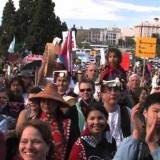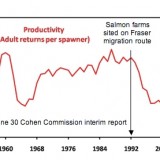It wasn’t until the final hours of the final day of the Cohen Commission into declining Fraser River sockeye, last Monday, that it truly became clear to me. After all the hundreds of thousands of pages of documents and thousands of hours of testimony made public by the Inquiry; after all the back and forth in the media about what has been happening to our wild fish – the whole issue will likely come down to how well First Nations, concerned conservationists and citizens work together to force real change on the Harper Government and that sorry, malfunctioning institution know as the Department of Fisheries and Oceans.
It was at this point that the appalling ignorance and disrespect at DFO and the Canadian Food Inspection Agency with regards to First Nations were lain bare before the Inquiry (articulated in this strongly-worded rebuttal from the Assembly of First Nations). Nicole Schabus, counsel for the Sto:lo Tribal Council and Cheam Indian Band – whose traditional territories encompass much of the Lower Fraser Basin – was grilling DFO’s Simon Jones about his lab’s discovery of an alarming number of Cultus Lake sockeye with indications ISA virus in the early 2000s. Jones’ post-doctoral student at the time, Dr. Molly Kibenge, had tested 64 out of 64 sockeye from the endangered Cultus stock positive for the virus.
The finding was later questioned in an email between Kibenge and Jones made public by Canada’s Counsel in the waning moments of the Inquiry – suggesting there may have been a problem with the test itself – but that would seem to argue for a fresh round of tests at the time, not the offhand dismissal of the troubling result, which is what in fact happened. Dr. Jones declined to publish Kibenge’s paper back in 2004 and furthermore neglected to pursue any follow-up tests – or even to disclose his lab’s findings to the Inquiry when it scheduled extra hearings to deal specifically with ISAv. Dr. Jones also failed to disclose these findings to Ms. Schabus’ client – despite the fact DFO took fish from their traditional territory for testing; and the fact the First Nation had been desperately searching for answers to the collapse of the Cultus stock and working hard to rebuild it.
But while DFO didn’t see fit to disclose its findings to the Stol:lo, it did notify representatives of the aquaculture industry at the time, the Inquiry learned – yet another slap in the face to First Nations.
Under questioning from the Sto:lo’s lawyer, DFO senior manager Stephen Stephen fell back on his default defence throughout his appearance at the Inquiry: “I want to reiterate, we do not report unconfirmed results.” Dr. Kim Klotins of the CFIA, seated next to him chimed in, “We did not involve the Stol:lo Nation – I didn’t realize there was an agreement with them.” Ms. Schabus fired back, “Not an agreement – an obligation!” (emphasis added).
Later, Krista Robertson, counsel for the Musgamagw Tsawataineuk Tribal Council (the Broughton Archipelago First Nations), asked Dr. Klotins whether the CFIA had consulted First Nations in the development of its “surveillance plan”, which will only begin to sample and test a few hundred fish for ISAv this Spring (they have yet to conduct a single sample and test of their own!). After much hemming and hawing, Dr. Klotins conceded, “We have not yet engaged in discussion with First Nations. We’re just putting that plan together and information will be put out in the New Year.”
Robertson continued, “Did you have communication with the First Nations in Rivers Inlet [where the ISA positives in Oct 2011 were reported]?” “No,” replied Dr. Klotins. Clearly, the CFIA could use a tutorial about its constitutional requirements in dealing with First Nations in BC. Judging by Dr. Klotins’ performance on the stand, it is as though they’ve never even heard of title and rights – nor would it appear have many of DFO’s higher-ups.
The Inquiry also saw an email communication between a First Nations fisheries officer asking a DFO representative whether his organization could offer any help in sampling wild sockeye to test for ISAv this Fall following the discovery of the virus in wild BC salmon. The DFO officer replied simply, “At this point in time we do not feel that more sampling for ISAv is warranted.”
Earlier on, under questioning from Leah Pence, counsel for the First Nations Coalition, Stephen Stephen had acknowledged DFO has not been communicating at all with First Nations with respect to ISAv. When Ms. Pence showed evidence that the BC Salmon Farmers’ Association’s chief flack Mary-Ellen Walling had been included in a technical briefing regarding ISAv on November 10, 2011, Dr. Klotins had nothing but empty stammering to offer in response.
In the brief time the three lawyers representing First Nations had with the witnesses on this final day of the Commission, a clear pattern emerged, wherein fish farmers enjoy far more inside access and special privileges with regards to ISAv and other important matters to do with wild salmon than do First Nations with constitutionally enshrined legal rights. And no one among the DFO and CFIA representatives on the stand had a remotely plausible explanation for this discrepancy.
Much has been made over the years by the likes of BC Conservative Party Leader John Cummins – who was unquestionably instrumental in making the Commission happen in the first place, in his former career as a federal Conservative MP – about abuses of the Food, Social and Ceremonial (FSC) fisheries by First Nations. The representative for the Fisheries Survival Coalition at the Inquiry, Phil Eidsvik, drew plenty of media attention when he questioned Ernie Crey, fisheries advisor to the Sto:lo Tribal Council, on the subject this past summer.
Mr. Eidsvik pressed Mr. Crey about a Globe and Mail article in which DFO alleged a “black market” has sprung up around the FSC fishery, whereby salmon for food and cultural practices, to which First Nations have a legal right, are being improperly sold for profit. Mr. Crey downplayed the allegation on the stand. “When we do sell fish that we catch, we do so under agreements with Fisheries and Oceans Canada. We also have food social and ceremonial fisheries. Those fish are intended for just what it’s described as,” Crey told the Inquiry. Mr. Eidsvik pressed on, asking whether the Sto:lo ever suffered from a lack of fish specifically due to these sales. “Not that I’m aware of,” Mr. Crey replied.
I don’t intend to wade into the complex legal debate about First Nations’ rights or lack thereof to sell FSC fish. Moreover, I’d be prepared to wager there are in fact abuses that occur within aboriginal fisheries – just as there are amongst commercial and sports fisheries. How many sporties sneak a barbed treble hook on the end of their line when they’re beyond the watchful gaze of fisheries officers – or stuff an extra Chinook or two in their cooler at the end of the day?
But those who choose to hang the whole mystery of disappearing Fraser sockeye on abuses within different fisheries are misguided in doing so; more importantly, they’re missing a golden opportunity presented by the Cohen Commission to deal with a much larger problem confronting our precious sockeye: namely, salmon farms. For never has there been a better window to clear the migratory routes of our Fraser sockeye of these virus and parasite breeding factories than now.
But it won’t happen with Justice Cohen’s non-binding recommendations, due out this summer (I’ll be surprised if the Commissioner can meet this revised deadline, especially in view of all the new eye-opening material and testimony entered into the record during the final three days of the Inquiry – dealing specifically with ISA virus). No matter how strong Justice Cohen’s report turns out to be, Stephen Harper can hardly be expected to implement it in full – nor, specifically, to take decisive remedial steps against the impacts of fish farms without the full force of media and public pressure.
The most instructive models to inform the path forward for dealing with open cage feedlots come from the campaigns currently being waged against the proposed Prosperity Mine and the Enbridge pipeline from the Alberta Tar Sands to Kitimat. Both have been – I would suggest – highly successful thus far; both involve squaring off against unsympathetic provincial and federal majority governments and large, wealthy resource corporations. Both have one more crucial thing in common: the unification of First Nations – holding constitutionally entrenched legal rights to their ancestral lands, waters and traditional ways of life – with environmental groups and non-aborigial citizens.
In the case of Taseko Mines’ proposed Prosperity Mine – in the Tsilhqot’in Plateau, west of Williams Lake – the project’s first iteration was rejected by none other than the Harper Government’s Ministry of Environment, following a strong opposition campaign led by the local First Nations, but supported by nearly every major environmental group in BC and legions of non-aboriginal citizens. When the company tried recently to begin work on a modified version of the mine – after being granted premature permits by the trigger-happy provincial Clark Government – it again ran smack into a wall. This time it came in the form of an injunction obtained by the Tsilhqot’in peoples at the BC Supreme Court, once again demonstrating the power of First Nations’ legal rights, backed up by vocal, committed non-First Nations supporters.
Of course, the Enbridge saga is far from over, but the historic banding together of 131 First Nations across Alberta and BC – again, backed by a large coalition of conservation groups, wilderness tourism operators and tens of thousands of highly mobilized citizens – will prove to be an insurmountable barrier for the pipeline, I would argue. The specific structure of this Enbridge opposition campaign – namely the “Save the Fraser Declaration“, a pledge to protect the waters, salmon, and traditional way of life of these communities and territories from the threat of an oil spill – could be easily adapted, or repeated in some form, to address the impacts of salmon farms.
The coalition is there already; its power has been demonstrated. All it would take would be for many of the same First Nations in the Fraser and Skeena watersheds to unite in opposition to salmon farms – with the full support of conservation groups, wilderness tourism operators and citizens, just as they have done with the Enbridge issue – and the Norwegian aquaculture behemoths would be facing a very comparable challenge to that which Enbridge now faces.
There is of course one major challenge to such a coalition – deeply embedded in the political protocols of First Nations. That is, First Nations don’t believe they should tell their neighbouring nations how to conduct themselves within their own territories. So while many First Nations are squarely opposed to the salmon farming industry, there are a few – around Campbell River, near Port Hardy, in Clayoquot Sound and near the village of Klemtu on the central coast, for instance – which have working relationships with the industry. But much like a pipeline or tanker traffic, what happens with fish farms within a given territory has effects which ripple beyond that nation’s borders.
And so, there is room – even a strong need – for diplomacy here. Such are the revelations of government cover-ups, the insulting special treatment of fish farmers and the severity of new viruses that have emanated from the Cohen Commission that no longer can these matters be left unspoken. It is time for the nations of the Fraser and Skeena basins to engage in a frank discussion with their neighbours who inhabit the migratory pathways of sockeye on the coast in order to ensure that wild salmon are adequately protected for the benefit of all First Nations and non-aboriginal peoples.
The highlight of the big rally for wild salmon in Victoria, led by Alexandra Morton in the Spring of 2010, was the coming together of First Nations and other fisheries groups who’ve long been at loggerheads over the sort of petty divisions alluded to earlier here. At this historic event were longtime rivals John Cummins and Ernie Crey, who crossed the Salish Sea together on the same ship, guiding a canoe filled with diverse supporters of wild salmon who had just paddled down the Fraser River – hosted by the Sto:lo and other First Nations along the way – to make their way to the provincial capital.
There was Hereditary Chief Frank Nelson of the Musgamagw peoples of the Broughton standing alongside old Billy Proctor – a veteran commercial pink salmon fisherman from the same region. Billy declared, “There’s been some divisions over the years, but it’s great to see us all getting together at last,” inspiring one of the day’s biggest cheers. Nelson followed, telling the crowd of over 5,000, “We’ve always been told that our drums beat like a heartbeat amongst our First Nations people. But I’ve heard all of us beating together on the drum today. We shall move forward to make every effort that Alexandra has done to ensure there is a place for our children.”
They all spoke of putting the past behind them and uniting in a common cause to rid our waters of fish farms.
That was less than two years ago, but so much has changed in that time. It is now clear from the Cohen Commission that we have more viruses affecting our wild fish than we’d even imagined. It is obvious that the DFO and CFIA see themselves far more are protectors and promoters of the salmon farming industry than as guardians of our wild fish and the public interest. It is also obvious that neither department, nor the salmon farming industry, views First Nations with anything less than complete and utter disrespect. And it is plain to see that our wild fish are dying more of greed and politics than they are of any natural cause.
So now is the time for First Nations – with their undeniable legal strengths – and all concerned conservation groups, businesses that depend on the health of our wild salmon and the ecosystems the support, and the citizens of British Columbia to come together as one and force the Harper Government to make good on the promise of the Cohen Commission and to take decisive action to rid our coastal waters of Norwegian fish farms.
It is only by our collective success or failure to bring about this result that we will be able to judge the true value of the Cohen Commission – and our own commitment to saving our treasured wild fish.







